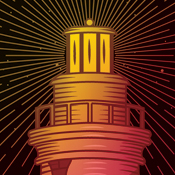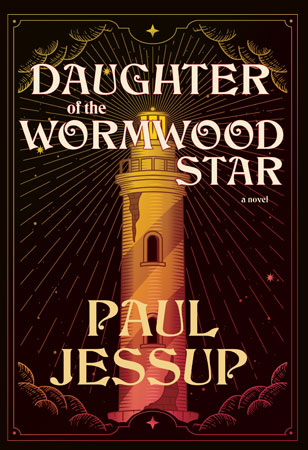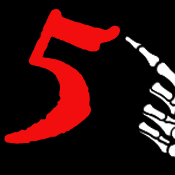To celebrate the release of Paul Jessup’s Daughter of the Wormwood Star, we got the author to answer a few questions about the inspiration behind the novel.

Underland: So, this book is a really eerie blend of folk horror, the occult, and some traditional splattercore. Where did the initial idea come from, and how did it grow into this story?
Jessup: This idea has been living in my head since I was about ten years old and stumbled onto The Omen II: Damien at a used bookstore. It was a slim paperback novelization of the movie, which I had never seen, nor seen the first one. But I got sucked in, and angry that Mark didn’t shout Hail Satan! and join his antichrist army, and instead betrayed his cousin. Then I gobbled up Rosemary’s Baby, watched the made for TV sequel, and then watched all the Omen movies and read a ton of “antichrist” style pulp rip offs.
I’m not sure why that kind of story appealed to me so much? Probably because my parents were Catholic, and it felt rebellious to not only be reading stories about the antichrist, but also wishing that he would embrace his evil and win. And also, why didn’t he ever start a cult? Around the time I was also reading a small gaudy paperback biography of one of the Manson girls. I can’t remember which one, but the book was fairly old and beaten up. She’d written it when she was in prison, and I was just absolutely fascinated with her point of view, when she fell in love with Manson, fell into the cult. All of that stuff. It just was so hypnotic and weird, and it tugged at some dark part of my brain.
So this story always stayed in the back of my head, and I became obsessed with other cults over the years (the seem to spring up in America like weeds), also reading about LaVey-style Satanism, getting into occult stuff in High School and College. This story always there, waiting to be written. I just didn’t have the start to it yet.
And then, a year ago, I felt like I had to sit down and finally write it. That it was time for me to do it. I’m not sure why, I couldn’t tell you. But part of my brain said, yes, now is the time to *finally* write it and get it out of your system. I started it a few different ways, always hard to get that antichrist just right. I know I wanted them to be older, and female. I know I wanted to pull in some stuff from Carrie, and Firestarter, as well as Scanners. I wanted to include road trip elements like Badlands or Natural Born Killers. But most of all, I wanted it to have this badass soundtrack, and I wanted to lean into extreme horror. I wanted to write a book that didn’t pull any punches at all.
But getting that start, how to introduce the characters, how will this all work? That was difficult. Eventually, I realized, I should just have it be other characters talking about our antichrist, Angelique Blackthorn. Since this was going to be about ambiguity, I wanted them to discuss the rumors of who she was, and have some of them be crazy and off the wall, and others be down to earth and pretty normal. And I wanted to do something unique, to not have them have their names attributed to what they were saying, like you were overhearing this from outside the room.
That was how I realized exactly what this book was going to be like, how it was going to be written, and how the reader will experience it. Nebulous, floating. The idea of who you are in a crowd, where you end and other people begin, will be key. Especially in something like a cult, where you can easily lose yourself and forget yourself and melt into the group. But also, I wanted to show how lonely it could be outside of it, how sad it could be once it ends. That there was something more complicated here than “group bad, individual good.”
And that all came to be in the first chapter, and I knew I could finally write this book.
Underland: The nameless “chatroom” motif that you mentioned is one of my favorite mechanics in this book. It reminds me of the interstitial advertisements in Grapes of Wrath that are a critique of exploitation and consumption, even in the face of such dire circumstances. In DAUGHTER OF THE WORMWOOD STAR, these chat sessions are almost like meta-commentary on what’s happening in the book itself — like observations on the genre and its conventions. What effect do you think this technique has on how readers view the cult? Does it make it more endearing? More horrifying?
Jessup: Oh yeah, I loved those bits in Grapes of Wrath, and I think the effect must’ve sunk into my subconscious somehow, to influence this in a way. Honestly the original plan, once I used that technique, was to just use it at the start and end of the book. But the more I wrote, the more I realized that it had to be something deep within the bones of the novel, that it represented so much of everything going on, and what I wanted to talk about when I was writing this.
I wanted to make the characters both more enduring at first, and more horrifying as it went along. As the cult begins to change shape, to sort of take on its own consciousness, a sort of group character, a egragore constructed of all the cult members mashed together. And how that can be horrifying, when it happens, and you start to realize that you’re losing parts of yourself, just as everyone else is losing parts of themselves. But I didn’t want that horror to just stand alone, as the usual “groups of people are bad,” that is done in folk horror and other kinds of cult horror movies and books. I wanted you to feel the inevitability, to understand why the characters join up, join in, and become a part of all this.
Not only are they endearing, and cute, and funny, but also lonesome and alone and seeking comfort from the world. They find a found family with each other, one with a very dangerous darkside. We hear a lot about the good sides of found family in fiction, but we know that these can be just as toxic or more than our flesh and blood families. Else, cults would be happy things and never make the news for the dangerous stuff they do, and streaming services would have far fewer documentaries to show.
But it’s all so complex, and I think these moments of nameless chats get us to see this happening in a way that feels modern. By that, I mean they almost feel like a Discord conversation, or a social media conversation, or even just texting back and forth between friends. It also, I think, talks about social media in that way, and the way groups of people can raise someone up to instant stardom, and then tear them down in a second.
Underland: There’s very definitely a darkly nostalgic nod to Satanic Panic in DAUGHTER. It takes me back to all those urban legends of blacked-out vans and abductions and the other nonsense that surrounded that moment. As you mentioned above, cults are hugely popular in the media — I confess, I’ll watch just about any documentary about any of them, especially if I’m out of true crime to watch. DAUGHTER is tapping into that trend in a fun way. Do you think folk horror, Satanism, and the occult are experiencing a little renaissance right now?
Jessup: Yeah, it’s interesting that they’re all coming back around in style now. I remember Satanic Panic in my childhood, my parents believed in it, in a weird way. The fear that was caused by shows like Geraldo stocking the flames. It’s oddly similar to how Qanon took off, and other forms of viral temporary insanity. When, where you actually sit down and look at it, it’s completely absurd! But in the time, in the moment, the absurdity can be appealing. I find that interesting.
And it’s kind of fun that cults and the occult are all back in style again. As someone who always loved that kind of stuff, I’m practically drowning in good books, documentaries and tv shows. While, for the longest time, we were kind of starved for that sort of thing. I wonder why there is such an interest in something that used to be so fringe and on the edges of society? Half these cults used to fly under the radar, but now we’re like . . . they were right here, under our very noses, being all culty. Maybe because cults are just key to America’s identity, right up there (hand in hand) with vast conspiracy theories and paranoia. We seem to have tons of fringe religions, with a lot of them slowly eeking out into mainstream society.
And very few of them (I noticed!) are based around Satanism and the antichrist. Well, come on now, why is that? Most of the LeVay style Satanism is all tongue in cheek the devil isn’t real, so we can do what we want. They yell out Hail Satan! all ironically, but where’s the fun in that? I wanted to take the Satanic Panic, take all those cults, and make it real. Combine all of them, so that the believers actually believe, unironically. In their mind there really is a devil.
Even though, within the text of the novel, I wanted it to be ambiguous. The characters are believers, but should we be? In the world of the novel, what is real? What isn’t? What are they actually experiencing here? The shifting ground I think is important. I remember back to Satanic Panic, and I think that’s a key question some of us asked or refused to ask. How much of this is really happening? Did we all just go insane for a little bit?
I go back to my childhood, and reading those books on the Manson girls, as well as Manson himself. Later on, I would also read biographies of tons of other cults and their leaders. Heaven’s Gate, all that sort of thing. Up until the present day with the documentaries. And what really brought me in was the sheer belief of every one of them. They seemed to have access to some kind of reality the rest of us couldn’t see. Where they delusional? Maybe. but in their eyes, this was all real and really happening. That’s terrifying to me on some level.
That one book, about the Manson girl. One of the strangest and scariest things in it was the ending, where she’s in prison and she finds God. She says giant celestial hands came down and cradled her and comforted her, and I thought, wow. In her mind, that was as real as the murders. That was as real as Manson himself, as real as the prison walls. I wanted to evoke that experience, that frame of mind. Where the fantastic is right there, butting up to reality.
But I had to do it mixed with ambiguity. I didn’t want the reader to walk away thinking “oh hey I know exactly what is real in the text.” Since that would be undermining the whole thing. It’s far scarier when we don’t know.
Underland: So, DAUGHTER is part of a loose, three-part series you’ve been doing with Underland, starting with GLASS HOUSE, and soon to move on to CANCER EATS THE HEART? How do the three inter-relate, and what can we look forward to from you in the next year or so?
Jessup: The three book loose trilogy is a trilogy in the same way as Carpenter’s Apocalypse Trilogy, or Shimizu’s Scary Village trilogy are trilogies. They contain themes that talk to each other, characters and places and seem to take place in the same world, but aren’t direct trilogies. It’s not like Lord of the Rings, or something like that. Each book can stand alone, but when read together they carry a deeper meaning and connection that’s pretty cool.
I call my trilogy of books The Hungry Void Trilogy. Since that seems to be a primary theme, existential terror personified. That idea of heat death of the universe seen as some monstrous entity that wants to undo reality. In Glass House you have the Child of the Abyss, the son of the Mothers of Sorrow. In Daughter of the Wormwood Star, you have the serial killer cult that worships the nothingness in the heart of reality, and in Cancer Eats the Heart, you have the Child of the Abyss returning to take on human form and undo reality. In that one, my disabled vampire novel, you have one of the siblings of the Mothers of Sorrow and the Child of the Abyss . . . one Mister Brightbones, who turns people into vampires so he can feed on the death they unleash in the world.
And like Glass House, each of the books has a powerful occult house that is used as a trap. Something built by wild occultists for their own sick an twisted purposes. In Glass House, it’s the titular Glass House; in Daughter of the Wormwood Star, it’s the House of Sky and Shadow. In Cancer Eats the Heart, it’s the Cannibal House, built by the same occultist that built Glass House, one Oliver Haddo. Here, in this book, we finally meet that insane architect, and learn why he creates such horrible architecture.
The book also references each other, since they’re all in the same shared universe. Cancer Eats the Heart takes place in the small Ohio town Dark Rivers, which is where Daughter of the Wormwood Star starts off (but doesn’t stay there). In Daughter of the Wormwood Star, you have characters singing Sunshine Family songs, not remembering where they heard them originally, only that they’ve wormed themselves into their minds.
As for the future? Well! I have lots of books inside me waiting to be written! I also have enough short stories for another collection. This one might be more loose, and include non-horror themed science fiction and fantasy. As well as some of my poems and non fiction essays. Hell, there might actually be enough non fiction for a book on writing, someday. I’m also going to be on quite a few podcasts soon. The Story Hour Podcast, Shaggy’s House of Horror Podcast, The Progressive Horror Podcast, as well as doing a reoccuring podcast for If this Goes On (Don’t Panic!) about Hope in Horror. Of course, I have my own round table podcast Fear is the Fire that Lights the Heart, that comes out at a semi-quarterly basis, depending on my free time.
There is also a lot of cool stuff planned for the release of Daughter of the Wormwood Star! One of them I can’t talk about just yet, but it’s going to be really cool. We’re still hammering out the details, so my lips are sealed. But damn, it’s going to be awesome. I’m also going to do a small book tour through Ohio, Pennsylvania, and New York State. Mostly around the northern ends of the states, within driving distance to where I live. So it’s going to be a big, awesome celebration of my little Antichrist Witchcult Roadtrip Novel. Say that three times fast, hah.



